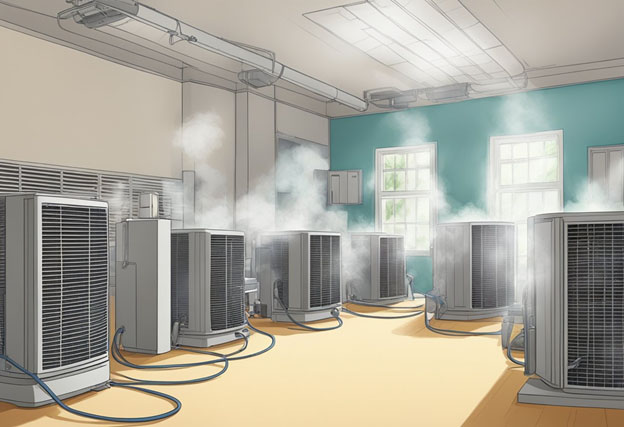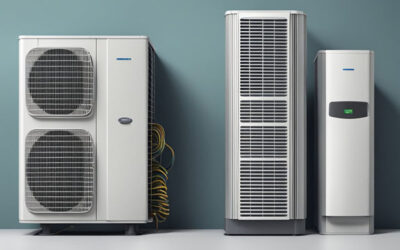Fans and air conditioning are two common ways to keep cool during hot weather. While both may provide relief from the heat, they work in very different ways. Understanding the differences between fans and air conditioning can help individuals make informed decisions about which option is best for their needs.
Fans are a popular and affordable way to stay cool. They work by creating a breeze that helps to evaporate sweat from the skin, which cools the body. Fans do not actually lower the temperature of the air, but they can make it feel cooler by creating air movement. Fans come in many different types, including ceiling fans, floor fans, and portable fans.
Air conditioning, on the other hand, works by removing heat and moisture from the air. It uses a refrigerant to cool the air and then circulates it back into the room. Air conditioning can be more effective than fans in very hot and humid weather, as it can lower the actual temperature of the air. However, air conditioning systems can be expensive to purchase and operate.
Basics of Cooling Technologies
Cooling technologies are essential for maintaining comfortable indoor environments, particularly during hot and humid weather. Fans and air conditioning units are two common cooling technologies used in homes and commercial buildings. While both technologies provide cooling benefits, they operate differently and have distinct advantages and disadvantages.
Fans are mechanical devices that circulate air and create a cooling effect through evaporation. The most common types of fans include ceiling fans, desk fans, and pedestal fans. Fans work by moving air over the skin, which helps to evaporate sweat and reduce body temperature. Fans are generally less expensive than air conditioning units and consume less energy. They are also easy to install and maintain.
On the other hand, air conditioning units use refrigerants to cool indoor air. The most common types of air conditioning units include window units, split systems, and central air conditioning. Air conditioning units work by removing heat and humidity from indoor air and replacing it with cool, dry air. They are highly effective at maintaining comfortable indoor temperatures and reducing humidity levels. However, air conditioning units are generally more expensive than fans and consume more energy. They also require professional installation and maintenance.
In summary, fans and air conditioning units are two distinct cooling technologies that operate differently and have unique advantages and disadvantages. Fans are generally less expensive and consume less energy, but they are less effective at reducing humidity levels. Air conditioning units are highly effective at maintaining comfortable indoor temperatures and reducing humidity levels, but they are more expensive and consume more energy. Choosing between the two technologies depends on individual preferences, budget, and specific cooling needs.
Types of Fans
When it comes to fans, there are a variety of options available. Each type of fan has its own unique features that make it suitable for different environments and preferences. In this section, we will explore the three most common types of fans: desk fans, ceiling fans, and tower fans.
Desk Fans
Desk fans are small, portable fans that are designed to be placed on a desk or table. They typically have a diameter of 6-12 inches and are powered by electricity. Desk fans are ideal for personal use, as they provide a focused stream of air that can be directed towards the user. They are also relatively quiet, making them a good option for use in an office or bedroom.
Ceiling Fans
Ceiling fans are mounted on the ceiling and circulate air throughout the room. They are typically larger than desk fans, with diameters ranging from 36-60 inches. Ceiling fans are powered by electricity and have multiple speed settings. They are a popular choice for bedrooms and living rooms, as they can help to reduce energy costs by allowing the user to rely less on air conditioning.
Tower Fans
Tower fans are tall, slim fans that are designed to take up minimal floor space. They typically stand between 30-40 inches tall and are powered by electricity. Tower fans are ideal for use in larger rooms, as they can circulate air throughout the space. They often come with additional features such as remote controls and multiple speed settings. Tower fans are also relatively quiet, making them a good option for use in a bedroom or living room.
In summary, each type of fan has its own unique features and benefits. Desk fans are portable and ideal for personal use, ceiling fans are mounted on the ceiling and circulate air throughout the room, and tower fans are slim and ideal for use in larger rooms. When choosing a fan, it’s important to consider the environment in which it will be used and the features that are most important to the user.
Types of Air Conditioners
Window Air Conditioners
Window air conditioners are the most common type of air conditioner used in households. As the name suggests, they are installed in a window, and they work by drawing in hot air from the room and expelling it outside. These air conditioners are relatively inexpensive and easy to install, making them a popular choice for those on a budget.
Window air conditioners come in different sizes, and the size you choose will depend on the size of the room you want to cool. It is important to choose the right size to ensure that the air conditioner works efficiently.
Portable Air Conditioners
Portable air conditioners are another popular option for those who want to cool a room. These air conditioners are freestanding units that can be moved from room to room. They work by drawing in hot air from the room and expelling it outside through a hose.
Portable air conditioners are more expensive than window air conditioners, but they offer more flexibility. They are ideal for those who live in apartments or for those who want to cool multiple rooms.
Central Air Conditioning Systems
Central air conditioning systems are the most expensive type of air conditioner, but they are also the most efficient. These systems are installed in the home and work by distributing cool air through ducts and vents.
Central air conditioning systems are ideal for those who want to cool their entire home. They are also more energy-efficient than window or portable air conditioners, which can save homeowners money on their energy bills.
In conclusion, there are different types of air conditioners available, and the one you choose will depend on your needs and budget. Window air conditioners are the most common and affordable, while portable air conditioners offer more flexibility. Central air conditioning systems are the most efficient but also the most expensive.
Functional Differences
Air Circulation
Fans and air conditioning units differ in the way they circulate air. Fans work by creating a breeze that moves air around the room, providing a cooling effect on the skin. On the other hand, air conditioning units circulate cool air throughout the room, which reduces the temperature of the air and creates a more comfortable environment.
Temperature Control
Fans do not have the ability to control the temperature of the air, but they can make the room feel cooler by creating air movement. Air conditioning units, on the other hand, have the ability to control the temperature of the air by cooling it down to the desired level.
Energy Efficiency
Fans are generally more energy-efficient than air conditioning units. They consume less electricity and are cheaper to operate. Air conditioning units require more energy to operate and are more expensive to run, but they can provide more effective cooling in extreme heat.
In summary, fans and air conditioning units have different functional differences. Fans are more suitable for mild temperatures and provide a cost-effective way to circulate air, while air conditioning units are more effective in extreme heat and provide temperature control.
Pros and Cons
Advantages of Fans
Fans are a popular choice for cooling homes and offices due to their affordability and energy efficiency. They are easy to use and require minimal maintenance. Fans also provide a gentle breeze that can be soothing and relaxing, making them ideal for use in bedrooms and living rooms.
Disadvantages of Fans
While fans are a cost-effective and energy-efficient cooling solution, they have certain limitations. Fans cannot cool the air in a room, they can only circulate it. This means that they are not effective in extremely hot and humid conditions. Fans can also be noisy and may not be suitable for use in quiet environments.
Advantages of Air Conditioning
Air conditioning is a popular cooling solution for homes and offices. It provides an effective way to cool the air in a room, making it ideal for use in hot and humid conditions. Air conditioning units are also available in a wide range of sizes and styles to suit different needs and budgets.
Disadvantages of Air Conditioning
While air conditioning is an effective way to cool a room, it is also expensive and energy-intensive. It requires regular maintenance to ensure optimal performance and can be noisy when in use. Air conditioning units also require professional installation, which can add to the overall cost. Additionally, air conditioning units can dry out the air in a room, which can be uncomfortable for some people.
Overall, both fans and air conditioning units have their advantages and disadvantages. The choice between the two will depend on individual preferences, budget, and specific cooling needs.
Environmental Impact
Carbon Footprint
When it comes to environmental impact, fans are generally considered to be more eco-friendly than air conditioners. Fans consume less energy and produce fewer greenhouse gas emissions compared to air conditioners. According to the US Department of Energy, an average fan uses only 10% of the energy consumed by an air conditioner, which means that it has a much lower carbon footprint.
Refrigerants and Ozone Depletion
Air conditioners, on the other hand, use refrigerants that can contribute to ozone depletion and global warming. Some older air conditioners use chlorofluorocarbons (CFCs) as refrigerants, which have been banned in many countries due to their harmful effects on the ozone layer. Newer air conditioners use hydrofluorocarbons (HFCs) as refrigerants, which are less harmful to the ozone layer but still contribute to global warming.
In summary, fans are generally considered to be more environmentally friendly than air conditioners due to their lower energy consumption and carbon footprint. However, it is important to note that the environmental impact of air conditioners can be reduced by using newer models that use more eco-friendly refrigerants.
Cost Considerations
Initial Investment
When it comes to initial investment, fans are generally much cheaper than air conditioning units. A basic ceiling fan can cost as little as $50, while a window air conditioning unit can cost upwards of $200. Central air conditioning systems can cost several thousand dollars to install.
Maintenance Costs
Fans are relatively low maintenance and do not require much upkeep aside from occasional cleaning. Air conditioning units, on the other hand, require regular maintenance to ensure they are functioning properly. This can include cleaning the filters, checking the refrigerant levels, and inspecting the electrical components. Professional maintenance services can cost anywhere from $50 to $200.
Operational Costs
Fans are much cheaper to operate than air conditioning units. On average, a ceiling fan uses only about 60 watts of electricity, while a window air conditioning unit can use anywhere from 500 to 1,500 watts. Central air conditioning systems can use even more electricity, resulting in higher utility bills. It is important to note, however, that fans only circulate air and do not actually cool it, so they may not be effective in extremely hot weather.
Overall, while fans may be a more cost-effective option in terms of initial investment and operational costs, air conditioning units may be necessary for those living in extremely hot climates. It is important to consider both the upfront and ongoing costs when deciding which cooling option is best for your home or business.
Choosing the Right Option
When it comes to choosing between fans and air conditioning, there are a few factors to consider. Here are some important considerations to keep in mind:
Climate Considerations
The climate you live in can play a big role in determining which option is right for you. If you live in a hot and humid area, air conditioning may be the better choice. It can help remove excess moisture from the air, which can make your home feel more comfortable. On the other hand, if you live in a cooler climate, a fan may be all you need to keep your home feeling comfortable.
Space and Size Constraints
Another important factor to consider is the size of your space. If you have a small room, a fan may be all you need to keep it cool. However, if you have a larger space, you may need to invest in an air conditioning unit to keep it comfortable. Additionally, if you have limited space, a fan may be the better choice since it takes up less room than an air conditioning unit.
Personal Preferences
Finally, personal preferences should also be taken into account. Some people prefer the feel of a fan since it provides a gentle breeze that can be refreshing on a hot day. Others prefer the cool, crisp air provided by an air conditioning unit. Ultimately, the choice between a fan and air conditioning will depend on your personal preferences and needs.
In summary, choosing between a fan and air conditioning comes down to a few key factors, including climate considerations, space and size constraints, and personal preferences. By taking these factors into account, you can make an informed decision about which option is right for you.





0 Comments